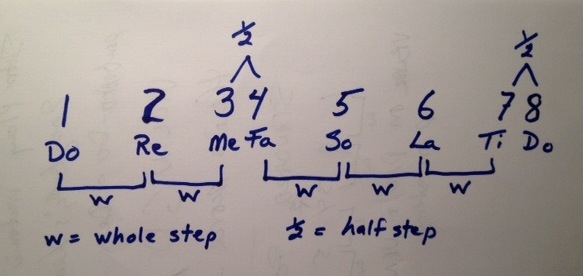So, what’s up with this major and minor (& other) thing, you may ask?…
Those who have studied modes a bit know that “Major” is not really the real name for this scale anyways (it is “Ionian”)…
So why is it deserving of the title: “MAJOR“???… is it really that big of a deal?
…well, the answer is… YES. Major scales are called “Major” because they ARE a rather big deal to musicians and how we explain and communicate how music works to each other.
Major scales have been chosen to be the “standard” which all other scales will be compared to, explained by… and even judged by!
Why???… Major is not better than other scales per say, but it is probably the most bright, happy, and balenced sounding (in a useful sort of way) of all the scales. Some, especially you Fiddle Jammers who have been exposed to the exciting Blues scales, may find if a bit boring maybe… but for the last 500 years or so, us humans have taken favor or a “shine” to it for some reason …maybe it represents the dominant mental and emotional state that we strive for???… no one knows for sure*, I’d guess, but the fact is, that the Major scale has been bumped up to become this standard.
*Side note #1: there may be other reasons Major is important to us too. The Christian Church and Bible has had more than a few things to say about our 7 note scales (including Major and the 6 other modes)… 7 being “the holy number of God” according to scripture… why God (if you believe in a God) did not choose 6, or 8, or even the much easier to count by 10, I do not know… but there it is… “7”… certain numbers do seem to come up more in our cultures. Seven being one of them. 7 natural notes. 7 modes, as mentioned above. Gamblers have “lucky 7.” 7 days in a week. 7 major glandular centers in our human bodies. 7 chakara centers. 7 colors in the rainbow. 7 wonders of the world. 7 seas… etc… (12’s and 5’s seem to come up a lot too, but we’ll save that for another lesson).
So, what does all this mean to us musicians exactly? As stated, Major is the standard all other scales are compared to. In the “Solfege” system of singing it is: “Do – Re – Me – Fa – So – La – Ti – Do” …most likely you’ve heard this somewhere before in your life?
<<<<audio of singing solfege>>>>>
Now the thing that makes Major “major” and a big deal is actually the particular combination of the spacing between its notes.
The basic building blocks of these musical spacings, or intervals as they are often called, is half and whole steps.
Half steps are notes that are close to each other… on the violin: fingers so close that they are touching each other or, on the piano: the next closest note. Ex: On the violin: F#2 to G3 on the D string, or on the piano: any B to C, or D# to E.
Whole steps are notes that are spaced fingers on a violin or, on the piano: having one key between them. Ex: On violin: D open to 1st finger E1 (with low 1 D#/Eb between them), or any A to B on a piano (with black key A#/Bb between them).
The Major scale as stated, has a particular order of half and whole steps that gives it its trademark “Do-Re-Me-” sound: whole – whole – half – whole – whole – whole – half. EVERY major scale shares this same exact spacing (other scales simply have different variants of this… which gives them their own unique sound too).
<<<<<graphic of major interval spacing>>>>>>
The Note Number System uses Major (or Ionian as it is called in mode “speak”) as it’s basis… only because it is the most common** sounding scale and the most familiar and most used scale “today” (including the past 500 years or so).
**Side note #2: Basing things on the most commonly used and most common sounding ideas is a common theme within many areas of music. This concept can also be found in chord symbols, rhythmic notation, time signatures, and other parts of music. Why?… this is not because the founders who first figured out how to write down what we musicians do, assumed that the rest of us were too dumb to figure it out any other way, or too lazy to try… but simply, as stated over and over here within the Fiddle Jam Institute materials: Music and the musician’s prime objective is to not just play music but actually EMOTE a feeling… and hopefully give, and maybe even get, GOOSEBUMPS!!!!! All systems must support this prime objective ultimately or else our music making is merely useless noise. Systems that are too complicated, or change too often, tend to distract us from this prime objective by making us think too much and feel too little. It is as simple as that.
So, major is “it”… all other scales and harmonic concepts are considered “as compared to Major.”
<<:next: learn about the note number system and other Music Mechanics concepts:>>
When done, you can go to the Next unit or click here to go back to the Music Mechanics 101 Table of Contents.
<<::>>
No comments yet.